Selvablue Wilderness lodge
by Bennett Hennessey
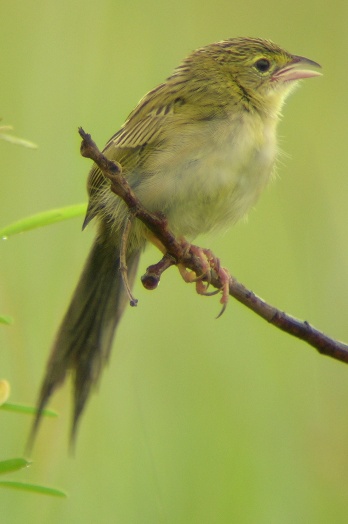 The Selvablue reserve holds over 350 bird species (bird list). The area protects an important Bolivian Cerrado habitat which includes the Vulnerable Rufous-sided Pygmy-Tyrant. Seventeen species of hawks & eagles have been recorded in the Selvablue area, with impressive numbers of other birds like, 8 species of pigeon, 12 species of parrot, 7 species of nightjar, 7 species of woodpecker, 10 species of antbirds, 13 species of tanager, 14 species of seedeater and finches and 37 species of flycatcher. The Selvablue reserve holds over 350 bird species (bird list). The area protects an important Bolivian Cerrado habitat which includes the Vulnerable Rufous-sided Pygmy-Tyrant. Seventeen species of hawks & eagles have been recorded in the Selvablue area, with impressive numbers of other birds like, 8 species of pigeon, 12 species of parrot, 7 species of nightjar, 7 species of woodpecker, 10 species of antbirds, 13 species of tanager, 14 species of seedeater and finches and 37 species of flycatcher.
The clearly distinct bird communities/habitat types are Cerrado, Dry Forest and scrub, Gallery Forest, Humid Savannahs and Aquatic ecosystems. Obviously many of these habitats mix and have combined areas but a visit to Selvablue should make sure to spend some time (a morning at best) in each habitat type.
Table 1. Diversity of Birds according to habitat
Habitat |
Species |
Cerrado |
125 |
Dry Forest |
94 |
Gallery Forest |
87 |
Humid Savannahs |
108 |
Aquatic ecosystems |
66 |
Selvablue Garden |
46 |
Cerrado
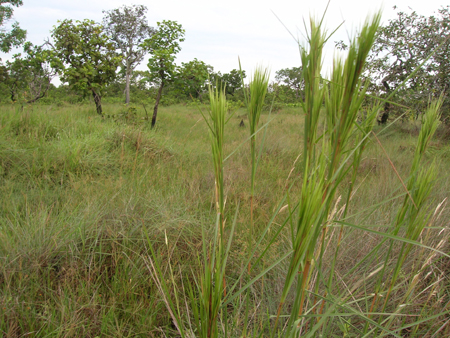 This is the most exciting habitat in Selvablue area as it protects some very interesting specialist birds hard to find in other areas. The Cerrado is a mosaic of several microhabitats with areas of dense woodland (actually closed to access- like the name Cerrado suggests), open areas, shrub areas and tall & short grasses. All the Cerrado in Selvablue is recuperating from many years of yearly burning and cattle grazing. Selvablue is now protecting this area from this nutrient depleting activity- but it will take time to recover, which is why monitoring and your records are important. This is the most exciting habitat in Selvablue area as it protects some very interesting specialist birds hard to find in other areas. The Cerrado is a mosaic of several microhabitats with areas of dense woodland (actually closed to access- like the name Cerrado suggests), open areas, shrub areas and tall & short grasses. All the Cerrado in Selvablue is recuperating from many years of yearly burning and cattle grazing. Selvablue is now protecting this area from this nutrient depleting activity- but it will take time to recover, which is why monitoring and your records are important.
One hundred and twenty-five species of birds have been recorded in the Cerrado habitat along Borochi track (Borochi is the local name for Maned Wolf), Perdiz track, and the Cerrado edge of Tejon track. Selvablue is one of the few places in Bolivia to see several Cerrado habitat specialists such as Ocellated Crake, Horned Sungem, Pale-breasted Spinetail, Rufous-sided Pygmy-Tyrant (Vulnerable of Extinction), Sharp-tailed Tyrant, White-rumped Tanager, Curl-crested Jay, Coal-crested Finch, and Black-throated Saltator.
The Cerrado habitat begins on Selvablue’s front door, on the runway leading to Borochi and Perdiz track. The Rufous-sided Pygmy-Tyrant was discovered by Jonathan Rossouw after much tape trawling) on the Perdiz track in August 2006 (S 12°45.446 W 65°49.378- the west side). The birds were singing within a large flock of Seedeaters. The Sharp-tailed Tyrant was also seen in this site, and in January along the Borochi track. It should also be noted that the Long-tailed Ground-Dove has only been found, repeatedly amongst the bushes at the end of the Borochi track, just before the tall grass at the port.
I suggest birding the area on foot and vehicle. On foot, follow bird song and loose foraging flocks. The Cerrado can be oddly silent, but where there is one bird, there are usually more. It is not necessary to know song, or have a tape recorded. Birding will be more productive leaving the track and walking through the tall grass towards the sounds that are of interest. But I suggest you augment your bird list by using the Selvablue vehicle, sitting up in the back during the slower parts of the late morning and afternoon. On the vehicle, search for the Greater Rhea and the Red-legged Seriema- both rare but possible to see. Also birding on the vehicle can be a nice escape from the bugs in January.

Figure 1. Simplified trail (footpath-Senda in Spanish) and track (4x4 track) map for Selvablue reserve area.
The Cerrado habitat in the Austral summer is dominated by Yellow-bellied Eleania, Small-billed Eleania, Mouse-coloured Tyrannulet, Grassland Sparrow, and Wedge-tailed Grass-Finch. In the Austral winter (June to Sept.) the area also has many confusing Austral migrant tyrannulets that can stump the best of them. And please, take good notes on new birds, as this is an important habitat that needs research and monitoring.
We hope this site could be the home to the threatened and very rare White-winged Nightjar, but we have yet to find it. As a night trip, leave from the lodge up Perdiz Track scanning for nocturnal birds and mammals. Often the Maned Wolf has been seen near the lodge. Drive out to the Tapacare Track, where many Nacunda Nightjars have been seen.
Dry Forest and Scrub
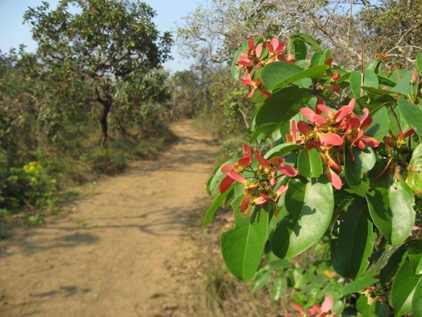 This habitat is classified as drier scrub, trees with a low canopy (10-15 m), heavy with vines and edged by gallery forest or Cerrado. A great example of this habitat is the woodlot just beside Selvablue Wilderness Lodge on Pejichi Senda (Trail in Spanish) (the only site we have found the Large-billed Antwren), Tejon Track (try playing Ferruginous Pygmy-Owl tape here- as there is a local resident and high mobbing response) and around the lodge. This habitat is classified as drier scrub, trees with a low canopy (10-15 m), heavy with vines and edged by gallery forest or Cerrado. A great example of this habitat is the woodlot just beside Selvablue Wilderness Lodge on Pejichi Senda (Trail in Spanish) (the only site we have found the Large-billed Antwren), Tejon Track (try playing Ferruginous Pygmy-Owl tape here- as there is a local resident and high mobbing response) and around the lodge.
The most obvious birds of this scrub are the Burnish-buff and Hooded Tanager. Curl-crested Jays are common in the austral winter (June-July) often eating Papaya around the lodge.
Natterer’s Slaty-Antshrike, a more local species in Bolivia, can be found at the beginning of the Tejon Track right beside the San Antonio Ranch (Tapacare) runway.
We found that when the Cerrado habitat is lifeless in the bright late afternoon sun, the dry forest of Pejichi trail beside Selvablue lodge can be active until Noon- and close by for lunch.
Gallery Forest
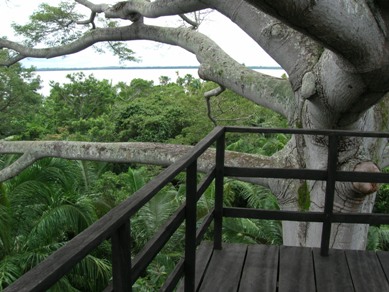 Gallery forests are tall forests sustained in drier areas by year round ground water sources bordering rivers and lakes. Often they can look, and feel like a tall terra firme forest, but the forest plant and animal diversity is diminished. But keep in mind that the Gallery forest in Selvablue is a bonus to an already rich area. Having said that, the forest still deserves a morning, especially if you will not be visiting any other humid lowland forests in Bolivia. Gallery forests are tall forests sustained in drier areas by year round ground water sources bordering rivers and lakes. Often they can look, and feel like a tall terra firme forest, but the forest plant and animal diversity is diminished. But keep in mind that the Gallery forest in Selvablue is a bonus to an already rich area. Having said that, the forest still deserves a morning, especially if you will not be visiting any other humid lowland forests in Bolivia.
Song knowledge and patience are the best skills in the forest. The ideal is to have a guide with bird song knowledge and the ability to conduct playback- but if not, travel slow, quietly and early (two hours as first light, is worth six hours during the midday). The best Gallery forest is the Sirenguero trail. At the entrance to the forest you should be able to find within the understory Black-throated Antbird, Warbling Antbird, Gray Antwren, and Fawn-breasted Wren. In the forest near the lake there is Blue-crowned Motmot, Black-fronted Nunbird, Chestnut-eared Aracari and Channel-billed Toucan. Well, there are also Screaming Pihas, as the name Sirenguero in Spanish states, but consider onceself incredible lucky to see this bird. Also keep an ear out for high frequency chips in the canopy- we saw a canopy foraging flock of six species in the area, including the impressive Paradise Tanager.
The Palm dominated forest of the Mapajo Mirador (observation tower) is also fantastic to observe Blue-and-yellow Macaws and other parrot species and a great place to get eye level with howler monkeys. One can also border Gallery forest at the Los Lobos observation tower which can be an interesting experience during the last two hours of light of the day.
The Point-tailed Palmcreeper has been recorded in the Mauritia lake edge palm forest by using song playback in the boat along the forest of the Sirenguero trail. It was found in an area of the lake good for snorkel fishwatching called the Delta.
Humid Savana
 Most of the department of Beni’s wetlands are described as Seasonally Flooded Savannas better labelled as Llanos de Moxos and locally called Pampas. These are low lying areas that are inundated for part of the year. They range from tall grasses, marshy bogs, swamps and mud flats. Most of this habitat is in relation to the heavy rains in Beni between December to April- when the majority is flooded, and to the strong dry season in July. Most of the department of Beni’s wetlands are described as Seasonally Flooded Savannas better labelled as Llanos de Moxos and locally called Pampas. These are low lying areas that are inundated for part of the year. They range from tall grasses, marshy bogs, swamps and mud flats. Most of this habitat is in relation to the heavy rains in Beni between December to April- when the majority is flooded, and to the strong dry season in July.
Selvablue holds an example of this habitat in Tapacare marsh, and Mirador Curichi (observation tower). This area contains a large marsh, wet grassland and a small river system. This is the only area I know of in Bolivia where one can see both the Horned and Southern Screamers side by side (biologists call this sympatric) and be sure to scan the large expanses for ducks, ibis, herons, and raptors. The Curichi observation tower also offers an excellent look-out of a large marsh bordered by gallery forest. The Curichi tower would make an enjoyable afternoon of morning if you have the time.
In the Austral winter groups of 10+ Nacunda Nightjars can be found along the drying grass fields beside the marsh. A great way to visit this area is in the afternoon birding until sundown, and then spot lighting at night around the marsh and along the drive back to the Selvablue Ecolodge.
Aquatic ecosystems
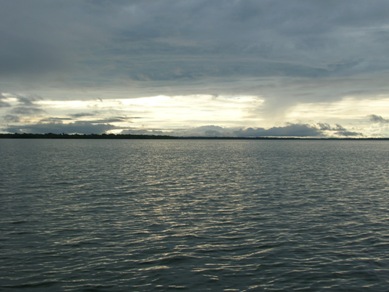 As the name Selvablue would suggest- the area is surrounded by interesting lakes and river systems. Selvablue carries the full complement of these aquatic birds. As the name Selvablue would suggest- the area is surrounded by interesting lakes and river systems. Selvablue carries the full complement of these aquatic birds.
Two outstanding areas are the canals Parabachi and Cucharona (Which is the local name for the Boat-billed Heron- which we have not seen but been told with certainty it exists in the area). Both are excellent for shutting off the motor and paddling with the current to closely observe the river edge birds. Canal Parabachi is an area dominated by palms popular with the Red-bellied Macaws and Blue-and-yellow Macaws for cavity nesting. Canal Cucharona contains a relaxing small river ecosystem with great chance to see Hoatzins, Greater Anis, Red-capped Cardinals, and Kingfishers.
Seasons
It is important to note that you can visit Selvablue Ecolodge any time of the year. Many other areas in Beni can become flooded during the rainy season, not allowing access or very poor access, but the Selvablue area sits on a raised iron rich substrate that does not become impossible to travel- no matter how much rain- the runway can always receive visitors.
Like most of Bolivia, the birds are affected by the seasons. Bolivia is the reverse of North America or Europe, with their summer being Bolivia’s winter. Basically summer is the green season from December to April. From April begins cooler temperatures and the possibility of southern winds from Argentina- surs in local language. A sur can drop the temperature by 10°C in two hours. The strongest Surs are in July and August- and usually last two to three days. Late July to September is the dry season- which means that late August to October there can be heavy grassburning and the possibility of smoky days.
 When is the best time to visit Selvablue? When is the best time to visit Selvablue?
That depends. To see the best of resident birds, it would be late October to late November, when birds are breeding. This will mean a lot of activity, more song and interesting displays. For shear numbers, it would be late June to early September to observe resident birds and Austral migrants from Argentina.
Bugs
You cannot see lots of birds without encountering some bird food, ie insects. Selvablue as part of the natural world has mosquitoes, deer flies, midges, ticks, etc. There are less in dry season, and some days are better than others. It is best to come prepared. Long sleeve shirts, long pants/trousers, socks, field shoes. Bring lots of repellent- using DEET, as that is the stuff that works. If the bugs are too much, you can get some relief on raised observation towers, paddling in a boat, and watching birds from the vehicle.
Routes
The ideal visit to Selvablue would be five days, allowing for a good morning in each habitat
• Gallery Forest
• Cerrado
• Dry forest
• Wetland
 Now remember, the best birding is at the crack of dawn, and the worst is the 3-4 hours of midday heat. Hence, the best logical approach is an early in the dark breakfast at 5h00 (in Dec- 6h00 in June), out at 5h30, lunch and siesta 11h00 to 15h00, and out until sunset. Now remember, the best birding is at the crack of dawn, and the worst is the 3-4 hours of midday heat. Hence, the best logical approach is an early in the dark breakfast at 5h00 (in Dec- 6h00 in June), out at 5h30, lunch and siesta 11h00 to 15h00, and out until sunset.
A suggested five day visit could be:
Day 1
Morning: Arrival
Lunch: Selvablue Ecolodge
Afternoon: Walk on Perdiz track Cerrado to Mirador Los Lobos
Day 2
Morning: Walking along Borochi Track observing birds of Cerrado.
Lunch: Selvablue Ecolodge
Afternoon: Drive out to Tapacare Humid Savannahs and Marsh. Remain there until nightfall.
Night: Torch scan the fields from Tapacare Track to Selvablue Wilderness Lodge
Day 3
Morning: Early drive to Mapajo tower gallery forest, the late morning Parabachi canal and Cucharona canal.
Lunch: On observation tower the lake.
Afternoon: Cerrado on foot and vehicle returning on Borochi Track.
Day 4
Morning: In Gallery forest Sirenguero, return late morning to visit Senda Pejichi near Selvablue Wilderness Lodge.
Lunch: Selvablue Ecolodge
Afternoon: Senda Taitetu in dry forest ending at Mirador Curichi sunset. Night light return drive.
Day 5
Morning: Early morning in Cerrado around Lodge.
Late morning flight out.
Logistics:
Selvablue Wilderness Lodge has space for 12 people, including a large dining area, swimming pool, and oper air bar. It is advisable to visit the lodge through a small plane flight in. Reservations can be made through Bird Bolivia, or see our Selvablue tour with English speaking bird guide. Vvehicle access is only possible with a 4x4 from June to September, and would requiere a reservation and a good plan. Road directions are rather complicated, but can be explained.
Click here for a Bird List of Selvablue Wilderness Reserve
|

